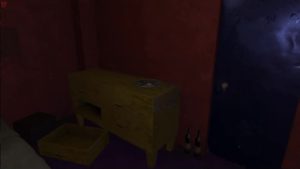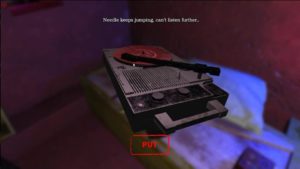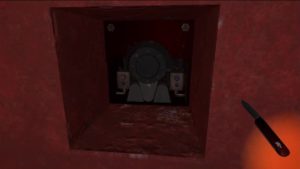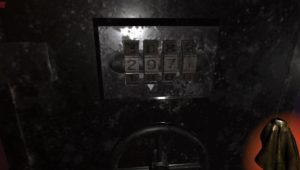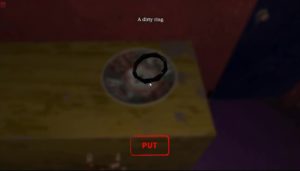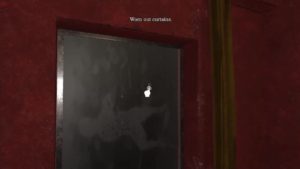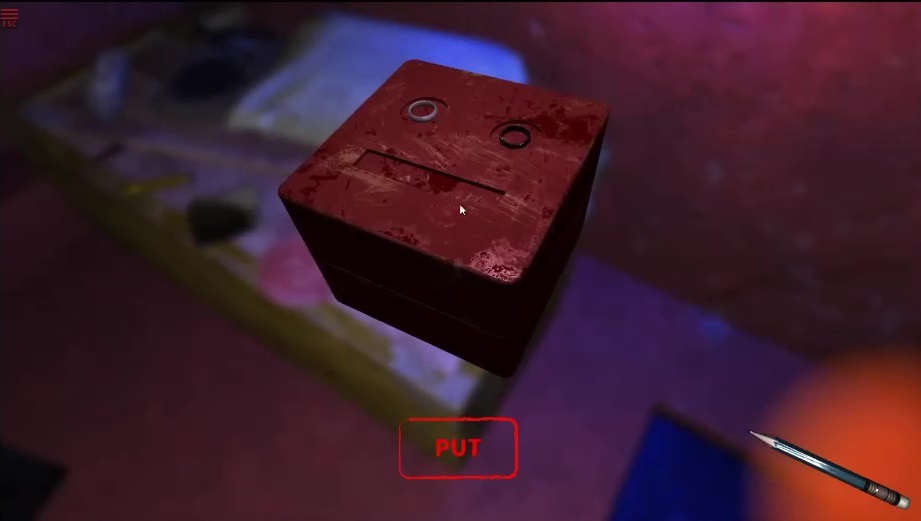

In 2004 Japanese artist Toshimitsu Takagi independently developed and released Crimson Room, a Flash-based PC game where the objective was to simply find a way to escape from the room you awake in by searching everywhere and using the various trinkets and objects you find to solve puzzles. This in turn often led to more puzzles which needed to be solved — and even some red herrings — until the player would eventually succeed and escape the room. Crimson Room was not the first game in its genre but due to its immense popularity it received the honor of being the one that defined it. As simple as Crimson Room was (it can be beaten in under a minute) its success was met with a staggering four sequels and an anthology compilation for the Nintendo DS. The most recent release in the series is 2016’s Crimson Room: Decade, a game that isn’t quite a sequel but isn’t quite a remake either. If I had to pin it down I’d say it’s a remix or re-imagining of the original.
The Crimson Room sounds like something that had some serious staying power… but in actuality the series ended almost as quickly as it started. White Chamber, the fourth game in the series, was released in 2005. Mind you, the original Crimson Room was published in 2004, only one year prior. After that? Nothing. Takagi hinted toward future installments in the series with “pink” and “tangerine” themes but these games were never completed and no prototypes or proof that any work on them has surfaced. Still, Crimson Room continued to remain in the consciousness of the public and its influence on the room escape genre was obvious. In 2007 the first three games were ported to the Nintendo DS. (White Chamber was presumably left out due to the complexity of the game’s 3D engine?) The anthology release for the Nintendo DS would be it for the series; nearly a decade of radio silence passed until 2016 when Degica Games released Crimson Room: Decade seemingly out of nowhere.
Given the name “Decade” one could easily infer that this is just an anniversary release with some fancier visuals; that’s mostly correct, even though if you do the math there’s actually a difference of 12 years and not 10, but Decade is not just a rerelease like the Nintendo DS compilation. This is its own game, and after playing it through on Gatorbox I can say with confidence that it’s one of the best games in the Crimson Room series. It may even be the best, but I’ll concede that’s definitely up for debate.

The fact that Decade takes place entirely in the original Crimson Room (for the most part) yet still manages to be different enough to be its own game is incredible. I’m almost positive when Takagi created the original game he never once thought that he would someday need to find a way to take the contents of the Crimson Room and repurpose them into something “similar but new”. That’s a hell of a task and given what little he had to work with I’d say he did a pretty damn good job. Decade does a lot of weird shit with the Crimson Room “mythos”, if that’s even a thing, and that’s what kind of ate at me the most as I played it. Canonically (again, assuming there even is a Crimson Room “canon”) the Crimson Room was a part of some nondescript building. You could open the curtains and see outside into the city below. The Crimson Room also led directly into the Viridian Room, the second game in the series. For the sake of convenience I’ll ignore the fact that the Viridian Room did not have another door to exit through.
That isn’t the case with Decade, though. In Decade I believe it’s implied that the Crimson Room is actually a cabin somewhere in a large ship named “Le Crimson”. To reflect this, there’s a postcard laying around in the room that has a photo of the ship on it as well as a calendar hanging on the wall featuring the same ship picture. It’s a little strange because of how different it was, but I suppose you could argue that the Crimson Room in and of itself is a concept and not an actual physical place that you can go to. Waking up “in the Crimson Room” is more of a symbolic thing and as such that means it can potentially be anywhere and take any form. That sounds like a bad page on the SCP wiki, but it’s plausible and I guess I can’t fault Takagi too much for taking things in a new direction. You can only do so much with one room, and this game manages to do a whole lot. The state of absolute disarray the room is in when you start is something you’ll eventually find a reason for as you progress through the game. There isn’t much more that I can say without spoiling the twists that Takagi is known for, but rest assured you will be surprised.
It’s very hard to discuss this game’s presentation without accidentally spoiling it, but the fact that you are in the Crimson Room is unmistakable. It’s the same room with the same proportions (mostly) and you will recognize most of the items from the first game. A couple things are missing however, namely the CD player. In its place is a portable record player however, so you can sort of imagine that as a 1:1 trade off. The concept of an “equal” trade off that replaces one item with a similar one factors into solving another one of the game’s puzzles later on; one aspect of Decade that I feel is worth commending is how many of these old items now have new uses or in some cases — such as the decorative antique dish with the ring in it — a use for the first time. When you tear open the curtains to try and shake a ring out of them like in the original game you’re met with no such prize, but if you look closely at the stains on the window you’ll recognize the unmistakable silhouette of the man pointing at the star from the projector in the first game. He’s still pointing at something in Decade, but I’ll leave it to you to find out what that “something” is.
Visually the game is kind of basic and I’m not sure if that’s a stylistic homage to the flat colors of the original or just evidence of a really tight budget and development schedule. If it’s an homage then it’s not a good one because flat colors are one thing, but stiff and drab textures are something else entirely. Still, you’ll have no problems telling what’s what and aside from a few strange graphical anomalies (like the light in the ceiling casting a square light beam) Decade’s appearance is “good enough”. Sound-wise there is very little to talk about but one thing that I just couldn’t get enough of is the fact that many of the original sound effects and even the “discovery” sting chords are reused in earnest in this game. They almost feel out of place because of how dated they are, but that feeling is immediately overwritten with how integral they were to the original Crimson Room experience. Over ten years later I was still getting chills each time I made a new discovery and heard those chords.

The biggest drawback of Decade and the games like it is that you can only solve it one time and once you’ve done that there really isn’t much more to do, but it’s the journey that counts and even though it’s been 15 years since I solved the original Crimson Room game I still look back on that initial playthrough fondly. The same can be said for Decade in the immediate scope but only time will tell if I feel the same way in another 15 years.
For a room escape game to feel fair its puzzles need to be somewhat understandable and not come off as something that you figure out purely on accident or out of frustration. Crimson Room was fairly basic in its approach: you find a couple of keys, you find some stuff that fits onto a box, you find a safe, done. If anything the biggest issues with the original Crimson Room games were their reliance on outside factors in order to provide clues to solve their puzzles (Crimson Room and White Chamber both required you to go to external websites which no longer exist today, for example). Decade however fails the “discovered this on accident” check at a few points. Some of the things that the game has you do don’t seem very intuitive. For example, there’s a bump in the sheets of the bed that you need to inspect with an item. The bump isn’t highlighted and the only way you’d know it was there was by dumb luck or by attempting to check that area because in the original game there was something hidden in approximately that same spot.
That brings us to another strange aspect of this game: playing the first one. You don’t actually need to have played the original game from 2004 to beat Decade but if you have then you’ll get a bit of a head start on some of the new puzzles like knowing to look at the aforementioned spot on the bed. You’d also know that messing with the curtains does something and that the stains on the window are the dancing guy from the projector who points at important things. You would also of course know that once you find the screwdriver you could use it on the door to escape… though that’s not the solution in Decade (but you do get an achievement for trying).
Overall I’d have to say that the puzzles in Decade make sense, but they don’t always “make sense”… if that makes sense. Again I can’t really start naming specifics without spoiling the game but Decade’s riddles exist in a weird superposition of being logical and illogical at the same time. When you figure out a solution you’ll say “oh I get that” but mentally you’ll disagree. The puzzles aren’t excessively hard or unfair, at least they weren’t to me, but I will acknowledge that they get a bit eccentric especially toward the end of the game. An ending that – in true Takagi fashion – makes no fucking sense whatsoever.
(NOTE: A game’s “Challenge” score is based upon the perceived fairness of its difficulty. Higher scores translate to a fairer and more satisfying experience. A low score reflects a game whose difficulty is either too high or too low.)

I like puzzles and I mean that in a few different ways. I like solving them, I like understanding the process of putting one together, I like the concept itself, I enjoy their presentation, etc. I personally had a lot of fun with Decade because I am a huge fan of the Crimson Room series. I am aware that my opinions are shaped by this fact however and acknowledge that for a not-insignificant portion of players they will have no prior experience to the series. The staggering number of talking heads on YouTube who dove into this game because they are still somehow cashing in on the trend of “people playing spooky games with a face cam on” proves this.
Decade is not a horror game. It may frighten you with its eerie atmosphere but it isn’t meant to scare the shit out of you. If anything Decade is just going to make you wrack your brain over what the fuck its meaning actually is. I know I did, and I think maybe I figured it out but explaining the elaborate metaphors behind Takagi’s games isn’t the point of this article. Besides, it all loops back around to me not wanting to spoil this game which I’ve discovered is extremely hard to do. It’s the lost challenge of the Crimson Room: not fucking up an online review of it and telling someone how it ends. Takagi is an artist known for his symbolism though, so as you play Crimson Room it helps to take it all in and really meditate on what the real meaning of the game is. Everyone has their own interpretations of it which is likely why the series has had such phenomenal staying power; the discussions you have about the games are almost as important and puzzling as the games themselves.
If you enjoy puzzles, you will probably like this game. (More so if you’re also a fan of its genre.) When you inevitably solve Decade for good you will probably be confused, but you will also feel accomplished nonetheless.

Decade is filled with homages and callbacks to the original game and I could go on at length about each of them but starting the game and waking up “in the room” in Decade takes the cake. The initial image of seeing the table and the blue door in the original Crimson Room is a screenshot that defined a genre. It is in my opinion one of the most important images in gaming. It might not be as instantly recognizable as that first wide pan across Hyrule Field in Ocarina of Time or as ubiquitous as the initial layout of World 1-1 in Super Mario Bros, but Crimson Room’s door is absolutely in that echelon of imagery.
To see that view recreated and presented once more in Decade is an amazing hook. You know from the start that you are trapped and it doesn’t really matter how you got in this room in the first place because if you can’t find a way out then you’re surely fucked. It’s the exact same lead-in as the first game and it works just as well the second time around. For people who played the original back in 2004 I would even go as far as to say Decade’s “wake up” scene works better than the first because it suggests that maybe you never really did escape all those years ago…

Yes. Crimson Room: Decade as a standalone game is an enjoyable experience for fans of the room escape genre. The puzzles aren’t too hard and the game rewards you for thinking outside of the box by way of giving you Steam achievements for being thorough with your investigations. It’s not a perfect game by any stretch but it’s firmly in the realm of being something worth your time. Existing fans of the series will probably enjoy re-familiarizing themselves with the iconic room and rediscovering the items from the original game and their new uses in this second go-around. Here’s to hoping Viridian Room someday gets the “Decade” treatment as well.

– Draco

